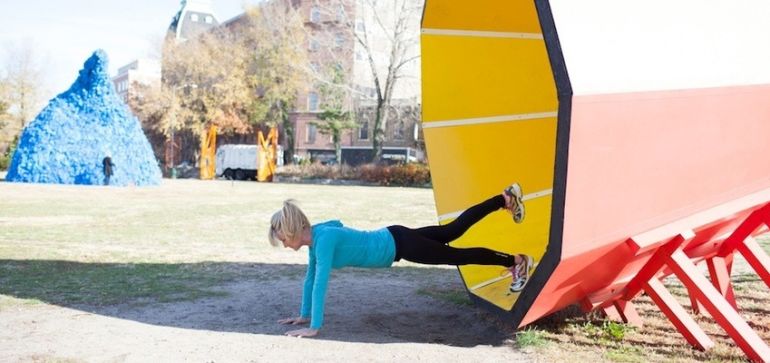Lose Weight > Common Sense To Lose Weight > Common Sense Article > How to Set Realistic Fitness Goals
How to Set Realistic Fitness Goals
 In life, we're told to dream big. Reach for the stars. Go for the gold. While I think everyone would agree that having big aspirations is admirable not to mention inspiring, you should take a more calculated approach when setting fitness goals. It may seem counterintuitive to start small, but remember that you want to set yourself up for success not burnout or injury.
In life, we're told to dream big. Reach for the stars. Go for the gold. While I think everyone would agree that having big aspirations is admirable not to mention inspiring, you should take a more calculated approach when setting fitness goals. It may seem counterintuitive to start small, but remember that you want to set yourself up for success not burnout or injury.Think about it. How many times have you or someone you know set a huge goal to lose 50 or more pounds, or exercise for an hour six days a week, only to fall off the wagon a few weeks (or days) later? The truth is that even when people have the best of intentions and the willpower to set out and do something grand, without a plan and a smart goal, they stumble—and are more likely to fail.
When you first set a goal, you're full of energy and completely motivated, but over time those feelings can wane and your overzealousness can push you to do too much too soon. The fix is to define a progressive set of fitness goals that build on one another to help propel you toward that big dream or aspiration. Breaking a big goal into smaller, realistic goals can help you both mentally and physically. This method can also help you improve your fitness level gradually and safely, which helps to build confidence.
The first step to setting realistic goals is to really think about your goal and write it down.
Then, ask yourself these three questions:
-
1. How big is the goal? Is your goal only attainable in three months or more? If so, make a or goals to get you to that long-term goal. Ideally, you should be able to reach the smaller goal in two to six weeks.
2. What does it take to achieve the goal? This question addresses your goal's frequency. If reaching your goal requires five workouts a week, but you can only get a babysitter two days a week, then you need to scale back your goal. Be realistic about what time you have to devote to the goal and be honest about your fitness level. Building your fitness base takes time, and being smart about increasing it will help you stay injury-free. As a general rule, never increase your weight lifted or your minutes exercised by more than 10 percent in any given week. Slow and steady really does win the race!
3. Can you see yourself reaching the goal? You want a program that you can stick with for the long haul—not just this week. Be completely honest with yourself and ask if you can realistically see yourself doing what it takes to achieve the goal at hand. If you can and it meets the above criteria, then you probably have a goal !
Unrealistic Goal for a Non-Competitive Exerciser: I want to complete an endurance event in two weeks. Competitive events are an excellent way to stay motivated and a great goal, but many triathlons and running races put a lot of wear and tear on the body, and if you do too much too soon (or without proper form or footwear), you can get injured, which really puts a damper on your dreams and is just plain painful!
Realistic Goal: I will complete a shorter distance endurance event like a 5K or sprint triathlon in three to six months. If you want to begin participating in endurance events, it's important to start building your fitness base slowly and really listen to your body. If you can walk comfortably for at least 20 minutes and can commit to working out four to five times a week for 20 to 40 minutes, then a 5K training program is a great place to start. A run/walk program is flexible and lets you see results over the course of just a few weeks, which is both exciting and motivational. Plus, if you get into it and find that you really despise running or it makes your knees hurt, you can walk and still reach your goal instead of giving up after the first week. Additionally, the time frame of two months is long enough—and the 5K itself is challenging enough—so reaching the goal is big enough to result in one of the best rewards of all: bragging rights!Unrealistic Goal for a Sedentary Person: I want to go to the gym every day. There are two main issues with this goal. First, it's not specific—what activities do you want to do and for how long? After all, just showing up at the gym doesn't accomplish anything unless you get your body moving. Second, it's not realistic. I love to work out and even I don't want to go to the gym every day. Plus, taking a day off here and there helps give your muscles time to repair and rest, and it gives you a break mentally.
Realistic Goal: I will be active for at least 10 minutes each day. While this goal isn't specific when it comes to the activity, it is specific and realistic with the time constraint. While going to an hourlong Spinning class every day would be impossible, not to mention not very healthy for you (cross-training is important so that no specific groups of muscles get overused), doing something active for 10 minutes a day, whether it's a walk after work, some push-ups or sit-ups over lunch, or a full session at the gym or with a workout DVD, is very doable. Also, note the addition of "at least" in this goal, which helps to emphasize that 10 minutes is just a minimum. Over time, this goal could progress to have a minimum of 15, then 20, then 30 minutes.Unrealistic Goal for a Novice Exerciser: I want to do the workout I did in high school. If you used to play a sport competitively when you were younger and are itching to get back into it, beware. Most sports require explosive and powerful movement that can give your body a rude awakening—such as extreme soreness or injury—especially when you try to do something that you haven't done in years. Even if you were the high school team captain, if you haven't practiced it in many years, start slowly and be cautious.
Realistic Goal: I will meet with a personal trainer once a week for a month and follow his or her strength routine two times a week. Even if you were MVP of your team back in the day, a lot has changed in sports performance and workouts over the last few years. Instead of going out and doing the same old workout that you remember from high school, take the time to meet with a personal trainer who specializes in your sport or regularly works with athletes. He or she can get you back in the sport saddle with a strength routine that prepares your body for competition and will help you prevent injury. A qualified personal trainer will also help you set other realistic goals once you've built your foundation to play. (If you're not sure how to look for a personal trainer or what else you need to ask, read this.)
Don't Forget to Reward Yourself
Perhaps the most important component of setting an effective and realistic fitness goal is rewarding yourself when you reach your goals, even the small ones! From buying yourself a new magazine to read, enjoying a long bath, or buying a new pair of workout shorts, the reward should be a time where you compliment yourself for your hard work and revel in your success.
Also, don't be afraid to tweak a goal as time goes by. Life happens! Remember, the key to setting yourself up for success is to be realistic. Now, start setting those goals!
Related Articles
-
Dieting To Lose Weight-What Should I Consume Exactly?
Obesity has always been a big problem to many who want to obtain a
-
Have You Been Feeling Sick? Why Getting Fit Is Vital!
Fitness not only makes you look better physically, but it can ha
-
At The Dinner Table
This Article was originally Published in The July 2004 Issue of The Zo
-
Fats Burning Furnace Evaluate – Why Rob Poulos is the Weight Loss Professional You Must Observe!
So you might have been contemplating Fat Burning Furnace but marvel if
-
Keys To Losing Weight And Gaining Self-Esteem
Unfortunately, weight loss is not a simple process for many peop
-
Healthy Weight Loss For Kids
With so many people concerned about the rising obesity rate in childre
- DON'T MISS
- Want To Lose Weight? Here’s How To Do It
- Time To Lose That Spare Tire
- The I’m-Not-On-A-Diet Diet
- Is There Such A Thing As A Fat Burning Diet?
- Great Reasons Why Natural Weight Loss Pills Are So Effective
- Weight Watchers Points List
- Chula Vista Weight Loss Resources - What Is Available?
- The Quickest Way to Lose Weight Permanently
- Hypnotic Weight Loss: The Secret Ingredient to Permanent Weight Loss?
- Fat Burning Yoga: Increase Workout Intensity




